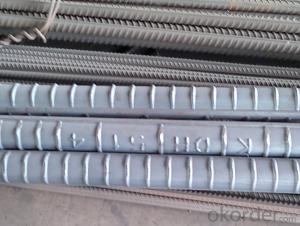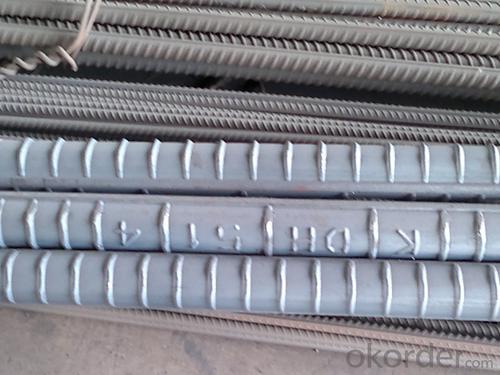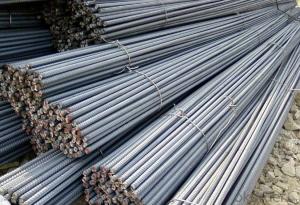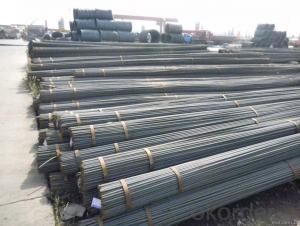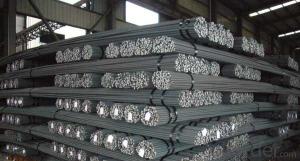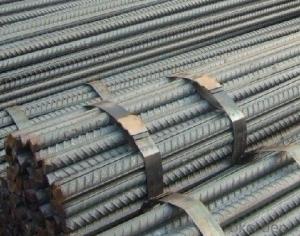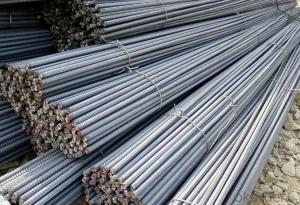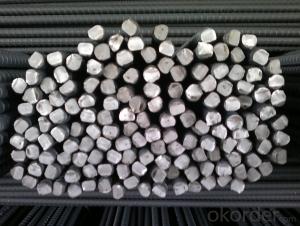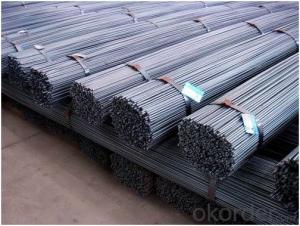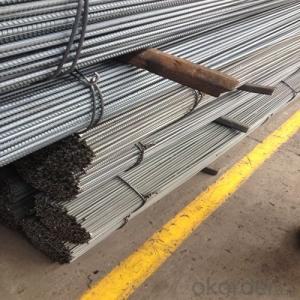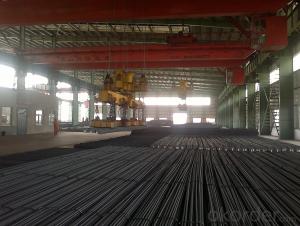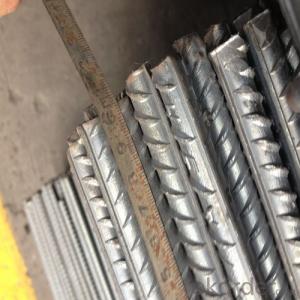Hot Rolled Deformed Steel Rebars ASTM, GB HRB400, HRB500
- Loading Port:
- Lianyungang
- Payment Terms:
- TT OR LC
- Min Order Qty:
- 25 m.t.
- Supply Capability:
- 200000 m.t./month
OKorder Service Pledge
OKorder Financial Service
You Might Also Like
Specifications of Hot Rolled Deformed Steel Rebars ASTM, GB HRB400, HRB500:
Standard | GB UK USA | HRB335 HRB400 HRB500 G460B, B500A, B500B,B500C GR40, GR60 | |
Diameter | 6mm,8mm,10mm,12mm,14mm,16mm,18mm,20mm, 22mm,25mm,28mm,32mm,36mm,40mm,50mm | ||
Length | 6M, 9M,12M or as required | ||
Payment terms | TT payment in advance or Irrevocable LC at sight. | ||
Each bundle weight | 2-3MT, or as required | ||
Trade terms | FOB, CFR, CIF | ||
Delivery Detail | within 45 days after received advanced payment or LC. | ||
Type | Hot rolled steel rebar | ||
Brand name | DRAGON | ||
Chemical Composition: (Please kindly find our chemistry of our material based on BS4449 as below for your information)
BS4449 500B | Chemical Composition | ||||
C | Mn | Si | S | P | |
0.24 | 0.45 | 0.16 | 0.05 | 0.31 | |
Physical capability | |||||
Yield Strength(N/cm²) | Tensile Strength(N/cm²) | Elongation (%) | |||
650 | ≥500 | 19 | |||
Deformed Steel Rebars in stock
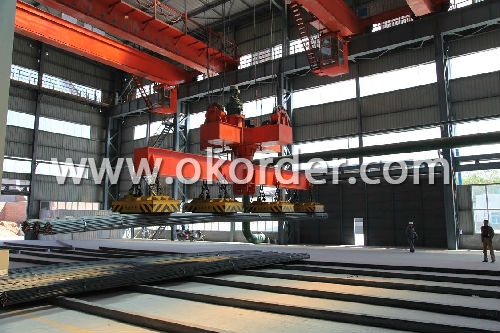
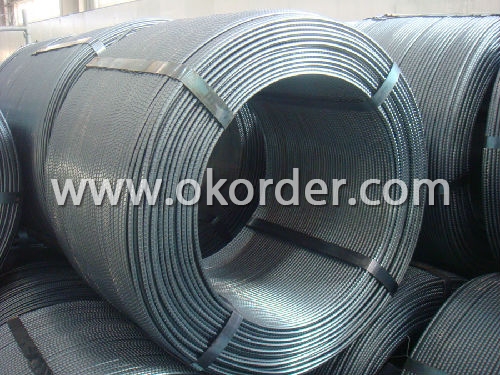
Usage and Applications of Hot Rolled Deformed Steel Rebars ASTM, GB HRB400, HRB500:
Deformed bar is widely used in buildings, bridges, roads and other engineering construction. Big to highways, railways, bridges, culverts, tunnels, public facilities such as flood control, dam, small to housing construction, beam, column, wall and the foundation of the plate, deformed bar is an integral structure material. With the development of world economy and the vigorous development of infrastructure construction, real estate, the demand for deformed bar will be larger and larger..
Packaging & Delivery of Hot Rolled Deformed Steel Rebars ASTM, GB HRB400, HRB500:
Packaging Detail: products are packed in bundle and then shipped by container or bulk vessel, deformed bar is usually naked strapping delivery, when storing, please pay attention to moisture proof. The performance of rust will produce adverse effect.
Price:Keep lower operating costs so as to offer competitive price for our clients
Label:to be specified by customer, generally, each bundle has 1-2 labels
Invoice:Actual or Theoretical Weight Basis as buyer’s request.
Note:
1. Our products are produced according to national standard (GB), if not, supply according to national standards (GB) or agreement as customer required.
2. Other Grade and Standard Deformed Steel Bar we can supply:
Grade: GR40/GR60, G460B/B500A/B500B/B500C,BST500S
Standard: ASTM, BS, DIN
The Minimum Order Quantity of these products is high, and need to be confirmed.
3. We can not only supply Deformed Steel Bar; if you need anything about building materials, please contact us for further information.
4. Please send us your detail specifications when inquire. We will reply to you as soon as possible. We sincerely hope we can establish a long stable business relationship.
- Q: How do steel rebars affect the overall load distribution of concrete structures?
- Steel rebars play a critical role in the load distribution of concrete structures. They enhance the overall strength and durability of the concrete by providing reinforcement. When concrete is poured, it is strong in compression but weak in tension. Steel rebars are embedded within the concrete to counterbalance this weakness and distribute the load more evenly. The presence of steel rebars helps to prevent cracks and structural failures by absorbing and distributing the tensile forces exerted on the concrete. As the load is applied to the structure, the steel rebars effectively transfer the tension forces to the surrounding concrete, which is highly resistant to compression. This load transfer mechanism results in a more balanced distribution of forces throughout the structure. Furthermore, the use of steel rebars increases the overall stiffness of the concrete structure. By resisting deformation, the rebars help to maintain the structural integrity and prevent excessive deflection under load. This is particularly important in large-scale concrete structures such as bridges, high-rise buildings, and dams, where the load distribution needs to be carefully managed to ensure stability. In summary, steel rebars significantly influence the load distribution of concrete structures by reinforcing the concrete and enhancing its tensile strength. They work in synergy with the concrete to evenly distribute and transfer the load, preventing cracks and structural failures. The combination of steel rebars and concrete creates a robust and reliable structural system capable of withstanding the applied loads and ensuring long-term safety.
- Q: Can steel rebars be used in airport runway construction?
- Yes, steel rebars can be used in airport runway construction. Steel rebars are commonly used in the construction of concrete structures, including airport runways, due to their high tensile strength and durability. They provide reinforcement to the concrete, enhancing its structural integrity and ensuring the runway can withstand heavy aircraft loads and repetitive impacts.
- Q: Can steel rebars be used in water treatment facilities?
- Yes, steel rebars can be used in water treatment facilities. Steel rebars, or reinforcing bars, are commonly used in construction projects to strengthen concrete structures. In water treatment facilities, where concrete is used for various structures such as tanks, basins, and pipelines, steel rebars are often incorporated to provide added strength and durability. Water treatment facilities involve the treatment of water to make it safe for consumption or other purposes. Concrete is a preferred material in these facilities due to its ability to withstand the harsh conditions of water treatment processes, such as exposure to chemicals, high temperatures, and pressure. Steel rebars are essential in reinforcing the concrete structures to ensure they can withstand these demanding conditions. The corrosion resistance of steel rebars is a critical factor to consider when using them in water treatment facilities. Since water treatment facilities often involve the use of chemicals and exposure to moisture, it is important to choose rebars that have appropriate corrosion protection. This can be achieved by using stainless steel rebars or by applying protective coatings to the rebars. It is also worth noting that proper design, construction, and maintenance practices are essential in ensuring the long-term performance of steel rebars in water treatment facilities. Adequate cover thickness, concrete quality, and proper installation techniques are important considerations to prevent corrosion and ensure the rebars provide the desired structural integrity. In conclusion, steel rebars can be effectively used in water treatment facilities to reinforce concrete structures and provide the necessary strength and durability. However, it is important to choose corrosion-resistant rebars and adhere to proper design and construction practices to ensure their long-term performance in these facilities.
- Q: Can steel rebars be used in the construction of underground parking structures?
- Yes, steel rebars can be used in the construction of underground parking structures. Steel rebars are commonly used in reinforced concrete structures to provide strength and durability. In underground parking structures, where the load-bearing capacity and structural integrity are crucial, steel rebars are essential in reinforcing the concrete to withstand the weight of vehicles and the underground environment.
- Q: What is the role of steel rebars in road bridge construction?
- Steel rebars are used in road bridge construction to provide reinforcement and strength to the concrete structures. They are embedded within the concrete to help distribute and bear the load, ensuring the bridge's durability and structural integrity. The rebars help to prevent cracking and improve the overall strength of the bridge, making it capable of withstanding heavy traffic loads and adverse weather conditions.
- Q: What is the composition of steel rebars?
- Steel rebars, also known as reinforced steel bars or reinforcing bars, are commonly used in construction projects to provide strength and reinforcement to concrete structures. The composition of steel rebars typically consists of primarily iron, with varying amounts of carbon and other alloying elements. The main component of steel rebars is iron, which provides the base material for their construction. Iron is combined with carbon to form steel, and the carbon content in rebars is generally around 0.2-0.3% by weight. This carbon content helps enhance the strength and hardness of the steel, making it suitable for reinforcing concrete structures. In addition to iron and carbon, steel rebars may also contain small amounts of other alloying elements, such as manganese, silicon, and sulfur. These elements are added in controlled quantities to improve specific properties of the steel, such as its durability, corrosion resistance, and weldability. Moreover, steel rebars are often produced with a ribbed or deformed surface to enhance their bond with the surrounding concrete. These surface deformations create a mechanical interlock between the rebar and the concrete, increasing the overall strength and stability of the reinforced structure. It is important to note that the exact composition of steel rebars may vary depending on the specific grade or standard being followed. Different countries and organizations may have their own specifications for steel rebars, which can dictate the allowable range of alloying elements and other parameters. Overall, the composition of steel rebars primarily consists of iron, carbon, and small amounts of other alloying elements, with the specific details varying based on the grade and standard being used.
- Q: What is the cost of steel rebars compared to other construction materials?
- The cost of steel rebars compared to other construction materials can vary depending on various factors such as geographical location, market conditions, and the specific type and grade of steel rebars being compared. However, in general, steel rebars are often considered more affordable and cost-effective compared to alternative construction materials such as concrete or wooden beams.
- Q: What is the role of steel rebars in minimizing cracking due to shrinkage?
- The role of steel rebars in minimizing cracking due to shrinkage is to provide reinforcement and strength to concrete structures. By placing steel rebars within the concrete, they act as a framework that helps distribute the tensile forces caused by shrinkage. This prevents the concrete from cracking and ensures the overall stability and durability of the structure.
- Q: What are the disadvantages of using steel rebars?
- One of the disadvantages of using steel rebars is their susceptibility to corrosion. Over time, exposure to moisture and other environmental factors can cause the rebars to rust, weakening their structural integrity. This corrosion can lead to structural damage and compromise the overall strength of the reinforced concrete. Additionally, steel rebars are heavy and can be difficult to handle and transport, which can increase construction costs and labor requirements.
- Q: How do steel rebars bond with concrete?
- Steel rebars bond with concrete through a process called mechanical interlocking, where the rough surface of rebars provides a strong grip with the concrete. Additionally, during the curing process, a chemical reaction occurs between the alkaline environment of concrete and the iron surface of the rebars, forming a layer of iron oxide that further enhances the bond strength.
Send your message to us
Hot Rolled Deformed Steel Rebars ASTM, GB HRB400, HRB500
- Loading Port:
- Lianyungang
- Payment Terms:
- TT OR LC
- Min Order Qty:
- 25 m.t.
- Supply Capability:
- 200000 m.t./month
OKorder Service Pledge
OKorder Financial Service
Similar products
Hot products
Hot Searches
Related keywords
